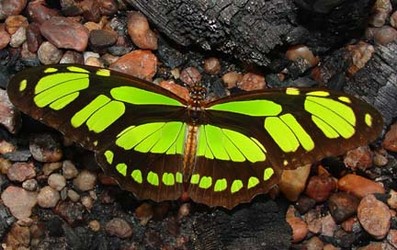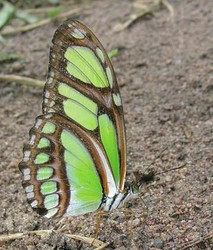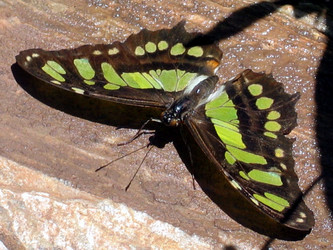Philaethria type species = Papilio dido L., 1763
Andrew V. Z. Brower and Margarita Beltrán- Philaethria andrei
- Philaethria browni
- Philaethria constantinoi
- Philaethria diatonica
- Philaethria dido
- Philaethria neildi
- Philaethria ostara
- Philaethria pygmalion
- Philaethria romeroi
- Philaethria wernickei
Introduction
Species in this genus are recognized by the translucent green and brown pattern on the upperside and the typical heliconiine elongate forewing. The genus ranges from Mexico throughout Central and South America (DeVries, 1987).
Philaethria larvae feed on several subgroups of the genus Passiflora, but unlike Heliconius, the larvae use the older leaves in all instars. The spiny larvae appear very much like Heliconius caterpillars, but the pupae lack spines and resemble a bird dropping. The adults are almost entirely restricted to the forest canopy, and do not feed on pollen. On the other hand, adults are occasionally seen visiting fresh mammal dung, a trait not seen in other heliconiines (DeVries, 1987). Flight is very rapid, and the butterflies are notoriously difficult to catch. Some have suggested that Philaethria species are mimicked by Siproeta stelenes (Nymphalinae), which are superficially quite similar, but lack the elongated forewings and exhibit more crenulated (almost "tailed") outer margins of the hindwings.
Two of the above Philaethria species were erroneously described in Siproeta by Röber, due to dire confusion over the typification of the genus in the 19th Century. The same problem led Stichel (1907) to propose Metamandana as a name for this genus, overlooking the fact that Billberg had much earlier provided a valid name.
Characteristics
In addition to the superficial characteristics of wing pattern discussed on the species pages, most Philaethria species are distinguished by differing haploid chromosome complements (Constantino & Salazar, 2010):
| P. andrei | n=12 |
| P. browni | n=67 |
| P. constantinoi | n=62 |
| P. diatonica | n=72 |
| P. dido | n=88 |
| P. neildi | n=52 |
| P. ostara | n=21 |
| P. pygmalion | n=29 |
| P. romeroi | n=21 |
| P. wernickei | n=29 |
Discussion of Phylogenetic Relationships
Long considered a single species (P. dido), Philaethria has in recent times been split into ten taxa based on differences in chromosome numbers, genitalic differences, and subtle variations in wing pattern. Although some potential affinities are implied by shared chromosome complements, it is premature to hypothesize relationships among the species of Philaethria. The species are listed in alphabetical order.
References
DeVries P. J. 1987 The Butterflies of Costa Rica and Their Natural History, Volume I: Papilionidae, Pieridae, Nymphalidae Princeton University Press, Baskerville, USA.
Lamas G ed. 2004. Atlas of Neotropical Lepidoptera. Checklist: Part 4A Hesperioidea - Papiionoidea. Gainesville: Scientific Publishers/Association of Tropical Lepidoptera.
Salazar Escobar JA. 1991. Descripción de una nueva especie de Philaethria Billberg, 1820 para el occidente de Colombia (Lepidoptera: Nymphalidae: Heliconiinae). SHILAP Revta. Lepid. 19: 273-279.
Constantino, L. M. and J. A. Salazar. 2010. A review of the Philaethria dido species complex (Lepidoptera: Nymphalidae: Heliconiinae) and description of three new sibling speceis from Colombia and Venezuela. Zootaxa 2720: 1-27.
Title Illustrations

| Scientific Name | Philaethria dido |
|---|---|
| Location | Alta Floresta, Mato Grosso, Brazil |
| Specimen Condition | Live Specimen |
| Identified By | Gill Carter |
| Life Cycle Stage | adult |
| View | dorsal |
| Source | Green Longwing |
| Source Collection | Neotropical Butterflies |
| Copyright | © 2003 Gill Carter |
| Scientific Name | Philaethria dido |
|---|---|
| Location | Brazil: Rondônia, Porto Velho, Rancho Grande |
| Specimen Condition | Live Specimen |
| Identified By | Kim Garwood |
| Life Cycle Stage | adult |
| View | ventral |
| Source | Green Longwing (Philaethria dido) |
| Source Collection | Neotropical Butterflies |
| Copyright | © 2006 Kim Garwood |
About This Page

Middle Tennessee State University, Murfreesboro, Tennessee, USA

University of Cambridge, Cambridge, UK
Correspondence regarding this page should be directed to Andrew V. Z. Brower at and Margarita Beltrán at
Page copyright © 2013 and
 Page: Tree of Life
Philaethria type species = Papilio dido L., 1763.
Authored by
Andrew V. Z. Brower and Margarita Beltrán.
The TEXT of this page is licensed under the
Creative Commons Attribution License - Version 3.0. Note that images and other media
featured on this page are each governed by their own license, and they may or may not be available
for reuse. Click on an image or a media link to access the media data window, which provides the
relevant licensing information. For the general terms and conditions of ToL material reuse and
redistribution, please see the Tree of Life Copyright
Policies.
Page: Tree of Life
Philaethria type species = Papilio dido L., 1763.
Authored by
Andrew V. Z. Brower and Margarita Beltrán.
The TEXT of this page is licensed under the
Creative Commons Attribution License - Version 3.0. Note that images and other media
featured on this page are each governed by their own license, and they may or may not be available
for reuse. Click on an image or a media link to access the media data window, which provides the
relevant licensing information. For the general terms and conditions of ToL material reuse and
redistribution, please see the Tree of Life Copyright
Policies.
- First online 25 March 2007
- Content changed 09 December 2011
Citing this page:
Brower, Andrew V. Z. and Margarita Beltrán. 2011. Philaethria type species = Papilio dido L., 1763. Version 09 December 2011 (under construction). http://tolweb.org/Philaethria/70437/2011.12.09 in The Tree of Life Web Project, http://tolweb.org/











 Go to quick links
Go to quick search
Go to navigation for this section of the ToL site
Go to detailed links for the ToL site
Go to quick links
Go to quick search
Go to navigation for this section of the ToL site
Go to detailed links for the ToL site